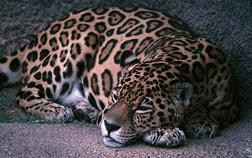JAGUAR
(EL TIGRE, YAGUARES)
Panthera onca
MAMMAL
Order Carnivora
Description
4-6 ft long, tail 2-3 ft, 2-2.5 ft. high at shoulder, 125-250 lbs, males larger and captive animals larger. Coat yellowish-brown but varies from near white to black, chest pale with black spots on belly, back marked with dark rosettes containing black spots. Lower part of tail ringed with black, black mark on lower jaw near the mouth. Outer surface of ear black with white stripe. Heavier and more compact body than leopards, with a broad, 'bulldog' face.
Range
extreme southwestern United States to central Patagonia

Status
This species is listed as endangered
and commercial trade of this species is prohibited by international law.
Its requirements for large territory to provide sufficient numbers of prey
animals are more difficult to meet in many areas. Poaching is still a significant
problem.
Photo © James P. Rowan Photography

 Ecology
Ecology
- Habitat
- tropical rain forest, swamps and open country, including desert and savanna; prefers good cover and easy access to water.
- Niche
- carnivorous: prey includes medium-sized mammals, birds, reptiles, amphibians, fish and eggs. Often buries prey in caches. Swims and climbs well, but will usually stalk prey on the ground by ambush; not a sprinter. Solitary and territorial, marking with urine and scratches. Usually grunts, snarls or growls rather than roaring.
Life History
Gestation 3-3.5 mo, 2-4 cubs born blind, 1.5-2 lbs. Cubs stay with mother about 2 yrs, mature at 3 yrs. Life span to 20+ yrs in captivity.
Special Adaptations
- Spotted coat breaks up body outline in dense cover.
- Heavily muscled forearms and shoulders add strength for capturing prey.
- Hindlimbs longer than forelinibs to facilitate jumping.
- Eyes in front to allow for depth perception and ability to isolate and capture prey.
- Forepaws equipped with long, retractile claws to help grab and hold prey.
- Rough tongue designed to peel skin of prey animal away from flesh, and flesh from bone.
- Loose belly skin allows animal to be kicked by prey with little chance of injury.
